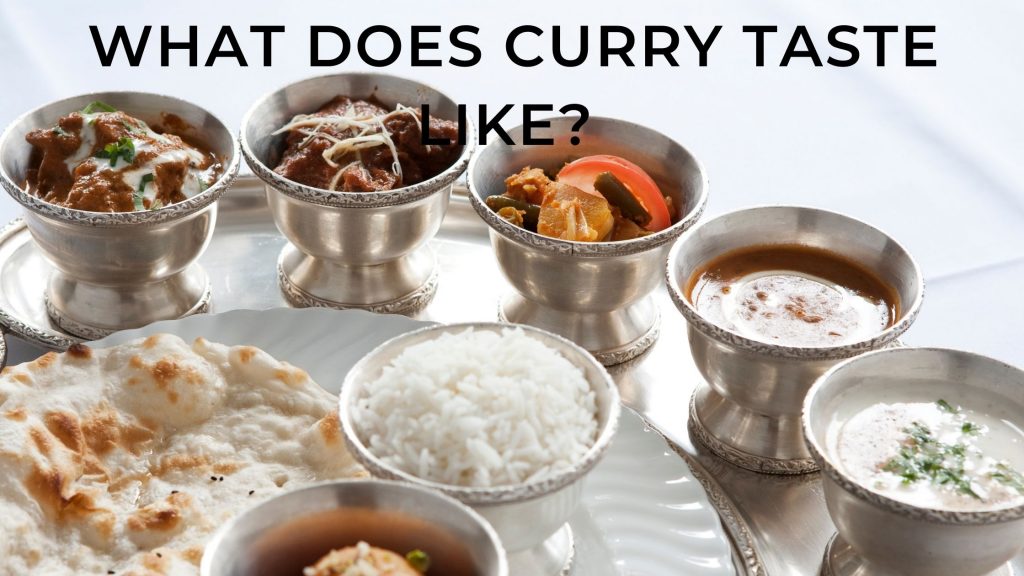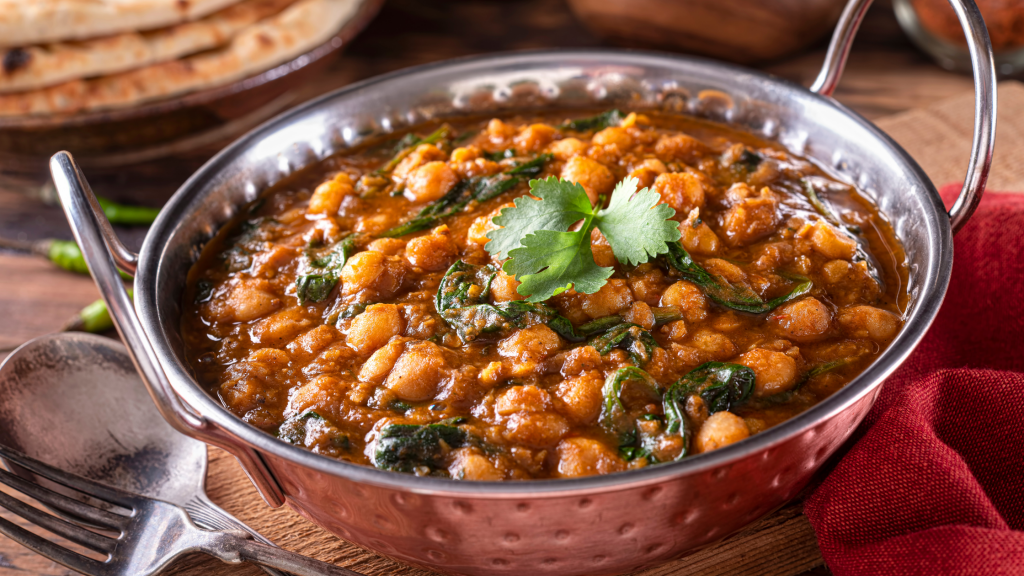Curry is a dish with a rich and complex flavor. It’s hard to pin down the exact taste of curry because that varies depending on what spices are used in the recipe. However, there are some general things that everyone agrees about when it comes to how they experience curry flavors. In this post, I’m going to go over those points and my personal opinion about what makes for an excellent curry dish!

What is curry?
Curry is a type of dish from the Indian subcontinent that is generally served with rice. The term “curry” is derived from the Tamil word Kari, meaning any sauce or relish to be eaten with rice.
In modern times, curry can refer to various dishes with their unique taste and preparation techniques. However, the most popular curries are usually a combination of spices, coconut milk or cream, and vegetables.
Curry can also be served with naan. Naan is an oven-baked flatbread found in cuisines of the North Indian subcontinent.
The most popular curries are usually a combination of spices, coconut milk or cream, and vegetables.
Curry is said to have originated from northeastern India. It then spread throughout the country along trade routes between Southeast Asia and India. Moreover, the Mughal Empire also introduced curry to other countries such as Persia, Somalia, and eventually Southeast Asia.
What does Indian curry taste like?
When it comes to Indian curries, there are a lot of different flavors. Indian curries use other spices. However, some of the most common include cumin, coriander, turmeric, ginger, and chili pepper. These spices all contribute their unique flavor profile to the dish.
For me, Indian curries always have a rich, deep flavor with an undercurrent of heat. The richness and creaminess of curries come from milk or coconut milk or cream and coconut cream. Either of these is added to curries depending on the recipe.
For example, north Indian curries are creamy, tangy, and lit. Heat is shadowed with creaminess from dairy milk or milk cream.
Water-based curries used to make beans and chickpeas are tangy and spicier.
South Indian curries are usually spicier anuses coconut milk for the base.
Different types of Indian curries

There are numerous different curries from the Indian subcontinent, each unique taste. The following is a list of some popular curries.
Vindaloo is a spicy curry that originated in Goa, made from caramelized onions, chilies, ginger, and tamarind. It typically has a tangy taste from vinegar and tamarind.
Vindaloo was introduced by Portuguese people when they came to Goa. They brought their dish called “carne de vinha d’alhos.” From this name originated the Vindaloo.
Saag is a curry that includes pureed mustard leaves, spinach, fenugreek leaves, and spices such as fenugreek, cumin seeds, or mustard seeds. This curry is made with lots of garlic and ginger.
Garlic is added while cooking the green leaves by boiling them in water. Green chilies are also a particular ingredient, not to be missed.
Korma is a curry typically made from meat or vegetables braised with yogurt and has a creamy, yogurt-like consistency. However, it is generally sweet to taste due to sugar and cashew nuts.
Mostly it is prepared with meat but it is adapted even to make vegetarian and vegan recipes.
Jalfrezi – A curry that includes various spices and vegetables such as green peppers, onion, and tomatoes. It has a tangy taste from vinegar, lemon juice, and green chilies. You can make Jalfrezi with vegetables and Paneer. To make it Vegan, you can add tofu instead of Paneer.
You can check the Jalfrezi recipe here.
Madras – A curry that includes a variety of spices, typically including black pepper, red chili powder, cumin seeds, and turmeric, which gives the dish its typical yellow color.
Different types of Thai curries
Thai curries are typically made with coconut milk and various spices, which gives them a distinctly sweet and spicy flavor. They often also contain peanuts or peanut butter, adding extra richness and creaminess to the dish. Those two ingredients also tend to be expected in Indian curries.
Red Curry: A curry paste made of dried red chilies, shallots, garlic, lemongrass, cilantro root (or coriander) sea salt, turmeric and shrimp paste.
Green Curry: Green curry gets its name from the green color of the chili paste from which it is made. It also tends to have a thicker consistency than red curry due to the number of green chillis. Green curry paste comprises similar ingredients like red curry but with a higher quantity of green chilies used in substitution for less fragrant fresh ingredients such as lemongrass and coriander root.
It has a distinct taste that combines sour, salty, and spicy with a subtle hint of sweetness.
Yellow Curry: Yellow curry comprises spices such as turmeric, ginger, coriander seeds, cumin, garlic powder, and lemongrass, which are sauteed in oil to extract their flavor before being added to the base mixture.
It differs from red and green curry in using turmeric instead of chili powder.
What does Japanese curry taste like?
Japanese curry for dinner, I made vegetarian Japanese curry from scratch. I created this recipe for a magazine about 10 years ago and it features in one of my classes too. I still love this and love slightly changing the recipe every time. Most Japanese … https://t.co/scCpO4f7un pic.twitter.com/rXxTOyqpcs
— Yuki’s Kitchen (@Yukiskitchen) March 1, 2018
Japnese curry is a type of curry dish created in Japan by combining traditional curry with local ingredients and cooking styles. Japanese curry began in Meiji Era( 1868- 1912) when the British Royal Navy Fleet came to Yokohama, Japan.
Curry powder was brought to Japan by Anglo-Indian officers of British Royal Navy.
As a result, many Japanese people started to develop a taste for curry. Over the next several decades, Japanese cooks adapted and modified Indian curry to suit Japanese tastes by using local ingredients.
Japanese Curry is usually stewed with onions and other vegetables and spiced with garam masala; recipes vary from spicy to mild.
The spices used in Japanese curry are very different from Indian curries. Although there are many variations, all types of Japanese curry contain some typical ingredients such as sugar, apple, honey, eggs, chicken stock, and carrots.
Like Indian curry, Japanese curry is usually thick and yellow. Simmering onions and carrots in oil and butter before adding other ingredients such as meat, vegetables, and spices create the savory taste of the thick sauce.
Japanese curry typically tastes sweeter than Indian curries because of the apples and honey in the recipe. In addition, Japanese curry is milder in flavor but thicker and more stew-like.
Japanese curry is a dish that adds its unique twist to the traditional Indian recipe. The ingredients used are very different from those used in Indian curries, and the taste is much sweeter than typical Indian curries because apples and honey are added.
How to eat curry?
There are many different ways of eating curry. Some people scrape the sauce off using naan bread, while others serve rice with it. No matter how you like your curry served, there is always one golden rule to follow; don’t mix it all!
The golden rule of eating curry is not to mix all the different elements as the spices and flavors work best when consumed as a separate dish.
Conclusion: What does curry taste like?
The taste of the curry depends a lot on the type of spices and herbs used to make the curry. However, one thing common in all the curries is the presence of chilies and different subtle flavors from added spices.
Eight significant differences between Indian and Thai curries?